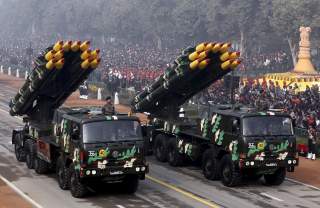A War Between India and Pakistan: Nuclear Weapons Could Fly (And Millions Die)
It would be awful.
Indian prime minister Narendra Modi and Pakistani prime minister Nawaz Sharif showed goodwill in a surprise meeting in 2015. Unfortunately, neither state appears capable of shaking out of its intractable pattern of conflict, driven by domestic political forces, which makes diplomatic accommodation difficult. The struggle for Kashmir occupies an important part of Pakistani national identity, and there has yet to be a civilian head of state in Islamabad with the will and authority to bring an end to cross-border infiltration and support for terrorist or insurgent fighters. For its part, the Indian Army has failed to respect local Kashmiri leaders and significantly improve its human-rights record.
In 2016 the killing of Kashmiri militant Burhan Wani led to an outbreak of domestic civil unrest in Kashmir that resulted in dozens of civilian deaths. After attackers killed seventeen Indian Army troops in Uri on September 18, the Indian army launched a cross-border raid under murky circumstances ten days later, followed by heavy exchanges of artillery and sniper fire in October and November that killed or injured dozens of civilians and soldiers on both sides of the Line of Control.
The United States sits awkwardly astride the two states. During the Cold War, the United States tilted in favor of Pakistan due to India’s good relations with the Soviet Union. Richard Nixon and Henry Kissinger, against the advice of the State Department, even dispatched a carrier task force in a futile attempt to dissuade India from its support of Bengali independence fighters. However, in recent decades, U.S. diplomacy has moved gradually in favor of democratic India, both due to its potential as a future superpower and its role as a counterbalance to Chinese influence. The role played by President Clinton in helping negotiate the end of the Kargil conflict in 1999 stood as a key turning point in the region—and marked one of the most dangerous confrontations in recent history, as it two nuclear-armed states were at risk of entering into full-scale conflict.
U.S. relations with Pakistan, meanwhile, have worsened despite a continuing flow of American arms for the Pakistani military. This mutual distrust is due to the presence of Islamic militant groups on Pakistani soil and U.S. drone strikes targeting them. Washington and Islamabad have genuinely diverging interests in regards to Afghanistan, the latter desiring to control Afghanistan out of fear that it might otherwise fall under Indian influence. Pakistan, however, can fall back on its relations with China if the U.S. alliance collapses, leading to a complicated diplomatic balancing act.
Despite diverging political agendas on the Indian subcontinent, there should be a common interest in limiting the proliferation of nuclear weapons and the likelihood of nuclear war. Growing arsenals in India and Pakistan serve to increase the catastrophic human cost of a potential conflict between the too, without evidently decreasing the frequency of inflammatory episodes of violence that spike tensions between the nuclear-armed states.
India and Pakistan will of course retain their nuclear arms, and continue to see them as vital deterrents to attack. However, for such policies to remain tenable in the long run, the longtime adversaries must seek to bring an end to a pattern of recurring conflict that is entering its seventh decade this year.
Sébastien Roblin holds a master’s degree in conflict resolution from Georgetown University and served as a university instructor for the Peace Corps in China. He has also worked in education, editing and refugee resettlement in France and the United States. He currently writes on security and military history for War Is Boring.
This first appeared in the Summer.
Image: Reuters.
Recommended: 5 Most Powerful Aircraft Carriers, Subs, Bombers and Fighter Aircraft Ever
Recommended: North Korea Has 200,000 Soldiers in Its Special Forces

